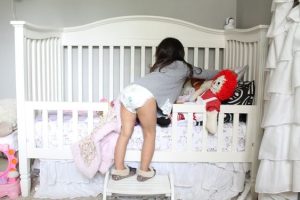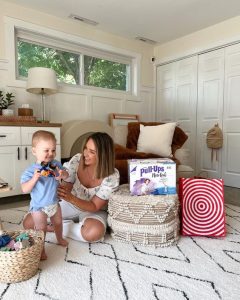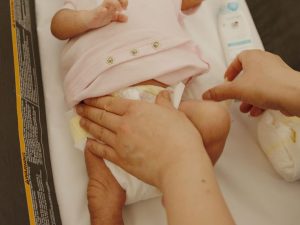Diapers and pull-ups are both absorbent underpants worn by children. However, there are some key differences between the two. Choosing the right option depends on your child’s age, development, and toileting habits.
Diapers: Absorbency and Security
Diapers are designed for maximum absorbency and leak protection. They feature:
Leakproof materials:
Diapers are made with absorbent materials that trap moisture and prevent leaks.
Snug fit:
Diapers have adjustable tabs or fasteners to ensure a snug and secure fit around the waist and legs.
Multiple sizes:
Diapers come in various sizes to accommodate babies and toddlers of different weights.

Types of Diapers
- Disposable diapers: These are the most common type of diaper. They are convenient and come in various absorbency levels.
- Cloth diapers: These reusable diapers are more eco-friendly but require washing and drying.
Pull-Ups: Transitioning to Potty Training
Pull-ups resemble underwear and are designed for toddlers who are potty training. They offer:
- Underwear-like feel: Pull-ups have a soft, elastic waistband that allows toddlers to pull them up and down like underwear, encouraging independence.
- Leak protection: While not as absorbent as diapers, pull-ups offer some leak protection for accidents during potty training.
- Easy removal: Pull-ups can be easily pulled down and disposed of, promoting self-sufficiency during potty training.
Signs Your Child Might Be Ready for Pull-Ups
- Shows interest in the potty: Your child may ask to use the potty or show curiosity about toilets.
- Stays dry for longer stretches: If your child’s diaper stays dry for two or more hours, they might be ready for potty training with pull-ups.
- Expresses discomfort in a wet diaper: Your child might communicate their dislike of a wet diaper, indicating they’re aware of bodily functions.

Choosing Between Diapers and Pull-Ups
Here’s a quick guide to help you decide:
- Diapers: Choose diapers for younger children who need maximum absorbency and leak protection.
- Pull-Ups: Transition to pull-ups when your child shows signs of potty training readiness and wants more independence.
Beyond Diapers and Pull-Ups
- Potty Training Underwear: These absorbent underwear offer minimal leak protection and are ideal for the later stages of potty training when accidents are less frequent.
- Reusable Training Pants: These resemble underwear but are made with absorbent materials to catch small accidents.
Diapers and pull-ups are both essential tools for parents during diaper-wearing stages. Understanding the differences between them can help you choose the right option for your child’s needs and development.
Considerations for Choosing Between Diapers and Pull-Ups
Here are some additional factors to consider when choosing between diapers and pull-ups:
- Activity Level: For active toddlers who move around a lot, diapers might offer a more secure fit and better leak protection.
- Blowouts: If your child experiences frequent blowouts, diapers with higher leak guards might be a better option.
- Nighttime Needs: For nighttime use, diapers are generally more absorbent than pull-ups.
- Cost: Disposable diapers can be a significant expense. Reusable pull-ups or cloth diapers might be a more cost-effective option in the long run.
Potty Training Tips
Pull-ups are a helpful tool during potty training. Here are some tips to make potty training a positive experience:
- Positive Reinforcement: Praise your child for their potty training efforts, regardless of accidents.
- Make it Fun: Use colorful charts, stickers, or songs to keep potty training engaging.
- Consistency is Key: Maintain a consistent potty schedule and routine to help your child learn.
- Be Patient: Potty training takes time. Be patient with your child and celebrate their progress.
Diapers and pull-ups are both valuable tools for parents during diaper-wearing stages. Understanding the differences between them and considering your child’s needs will help you choose the right option. Remember, potty training is a journey, and there will be ups and downs. Focus on creating a positive and supportive environment for your child.
Beyond the Basics of Diapers and Pull-Ups
While diapers and pull-ups are the primary underpants for young children, there are other options to consider as your child progresses in their potty training journey.
-
Potty Training Underwear: These look and feel like regular underwear but offer minimal leak protection. They are ideal for the later stages of potty training when accidents are less frequent. This reinforces the feeling of wearing regular underwear and can motivate continued potty training success.
-
Reusable Training Pants: These resemble regular underwear but are made with absorbent materials to catch small accidents. They are a reusable option that can be more cost-effective than disposable pull-ups. However, they do require washing after each accident.
Choosing the Right Fit
Proper fit is important for both diapers and pull-ups to ensure comfort and prevent leaks. Here are some tips:
- Look for snug but not tight fit around the waist and legs.
- Adjustable tabs or fasteners on diapers allow for a customized fit.
- Pull-ups should be easy for your child to pull up and down on their own, encouraging independence during potty training.
Environmental Considerations
Disposable diapers can create significant landfill waste. If you’re looking for eco-friendly options, consider:
- Cloth Diapers: These reusable diapers are an eco-friendly option but require washing and drying. There is a learning curve for using cloth diapers effectively, but many parents find them rewarding in the long run.
- Biodegradable Disposable Diapers: These diapers are made with plant-based materials and are designed to decompose faster than traditional disposable diapers.
Traveling with Diapers and Pull-Ups
Whether you’re venturing out for errands or taking a family vacation, traveling with a young child requires extra preparation. Here are some tips for navigating diaper and pull-up changes on the go:
- Packing Essentials: Pack plenty of diapers or pull-ups, depending on your child’s needs. Consider the number of changes needed per day and add extras in case of accidents or delays.
- Portable Changing Pad: A wipeable changing pad creates a clean surface for diaper changes anywhere.
- Diaper Bag Backpack: A backpack-style diaper bag frees up your hands for carrying your child or other essentials.
Conclusion
Diapers and pull-ups play an important role in caring for young children. By understanding the differences between them and considering your child’s development and needs, you can choose the best option for each stage. Remember, potty training is a journey with ups and downs. Patience, positive reinforcement, and the right tools can make it a successful experience for both you and your child.








